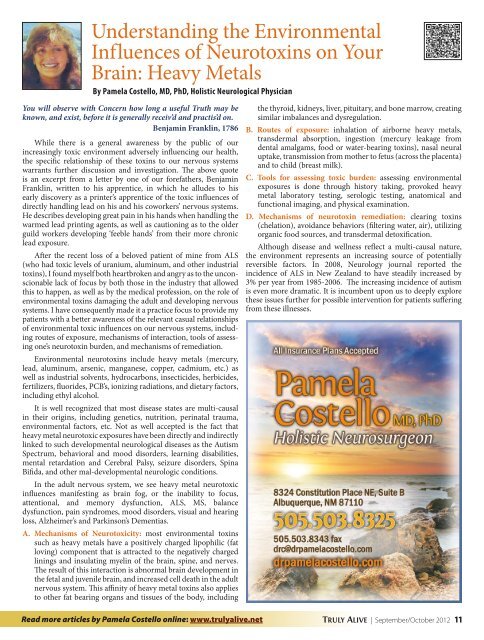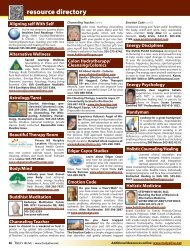Download - Truly Alive Magazine
Download - Truly Alive Magazine
Download - Truly Alive Magazine
Create successful ePaper yourself
Turn your PDF publications into a flip-book with our unique Google optimized e-Paper software.
Understanding the Environmental<br />
Influences of Neurotoxins on Your<br />
Brain: Heavy Metals<br />
By Pamela Costello, MD, PhD, Holistic Neurological Physician<br />
You will observe with Concern how long a useful Truth may be<br />
known, and exist, before it is generally receiv’d and practis’d on.<br />
Benjamin Franklin, 1786<br />
While there is a general awareness by the public of our<br />
increasingly toxic environment adversely influencing our health,<br />
the specific relationship of these toxins to our nervous systems<br />
warrants further discussion and investigation. The above quote<br />
is an excerpt from a letter by one of our forefathers, Benjamin<br />
Franklin, written to his apprentice, in which he alludes to his<br />
early discovery as a printer’s apprentice of the toxic influences of<br />
directly handling lead on his and his coworkers’ nervous systems.<br />
He describes developing great pain in his hands when handling the<br />
warmed lead printing agents, as well as cautioning as to the older<br />
guild workers developing ‘feeble hands’ from their more chronic<br />
lead exposure.<br />
After the recent loss of a beloved patient of mine from ALS<br />
(who had toxic levels of uranium, aluminum, and other industrial<br />
toxins), I found myself both heartbroken and angry as to the unconscionable<br />
lack of focus by both those in the industry that allowed<br />
this to happen, as well as by the medical profession, on the role of<br />
environmental toxins damaging the adult and developing nervous<br />
systems. I have consequently made it a practice focus to provide my<br />
patients with a better awareness of the relevant casual relationships<br />
of environmental toxic influences on our nervous systems, including<br />
routes of exposure, mechanisms of interaction, tools of assessing<br />
one’s neurotoxin burden, and mechanisms of remediation.<br />
Environmental neurotoxins include heavy metals (mercury,<br />
lead, aluminum, arsenic, manganese, copper, cadmium, etc.) as<br />
well as industrial solvents, hydrocarbons, insecticides, herbicides,<br />
fertilizers, fluorides, PCB’s, ionizing radiations, and dietary factors,<br />
including ethyl alcohol.<br />
It is well recognized that most disease states are multi-causal<br />
in their origins, including genetics, nutrition, perinatal trauma,<br />
environmental factors, etc. Not as well accepted is the fact that<br />
heavy metal neurotoxic exposures have been directly and indirectly<br />
linked to such developmental neurological diseases as the Autism<br />
Spectrum, behavioral and mood disorders, learning disabilities,<br />
mental retardation and Cerebral Palsy, seizure disorders, Spina<br />
Bifida, and other mal-developmental neurologic conditions.<br />
In the adult nervous system, we see heavy metal neurotoxic<br />
influences manifesting as brain fog, or the inability to focus,<br />
attentional, and memory dysfunction, ALS, MS, balance<br />
dysfunction, pain syndromes, mood disorders, visual and hearing<br />
loss, Alzheimer’s and Parkinson’s Dementias.<br />
A. Mechanisms of Neurotoxicity: most environmental toxins<br />
such as heavy metals have a positively charged lipophilic (fat<br />
loving) component that is attracted to the negatively charged<br />
linings and insulating myelin of the brain, spine, and nerves.<br />
The result of this interaction is abnormal brain development in<br />
the fetal and juvenile brain, and increased cell death in the adult<br />
nervous system. This affinity of heavy metal toxins also applies<br />
to other fat bearing organs and tissues of the body, including<br />
the thyroid, kidneys, liver, pituitary, and bone marrow, creating<br />
similar imbalances and dysregulation.<br />
B. Routes of exposure: inhalation of airborne heavy metals,<br />
transdermal absorption, ingestion (mercury leakage from<br />
dental amalgams, food or water-bearing toxins), nasal neural<br />
uptake, transmission from mother to fetus (across the placenta)<br />
and to child (breast milk).<br />
C. Tools for assessing toxic burden: assessing environmental<br />
exposures is done through history taking, provoked heavy<br />
metal laboratory testing, serologic testing, anatomical and<br />
functional imaging, and physical examination.<br />
D. Mechanisms of neurotoxin remediation: clearing toxins<br />
(chelation), avoidance behaviors (filtering water, air), utilizing<br />
organic food sources, and transdermal detoxification.<br />
Although disease and wellness reflect a multi-causal nature,<br />
the environment represents an increasing source of potentially<br />
reversible factors. In 2008, Neurology journal reported the<br />
incidence of ALS in New Zealand to have steadily increased by<br />
3% per year from 1985-2006. The increasing incidence of autism<br />
is even more dramatic. It is incumbent upon us to deeply explore<br />
these issues further for possible intervention for patients suffering<br />
from these illnesses.<br />
Read more articles by Pamela Costello online: www.trulyalive.net<br />
<strong>Truly</strong> <strong>Alive</strong> | September/October 2012 11














